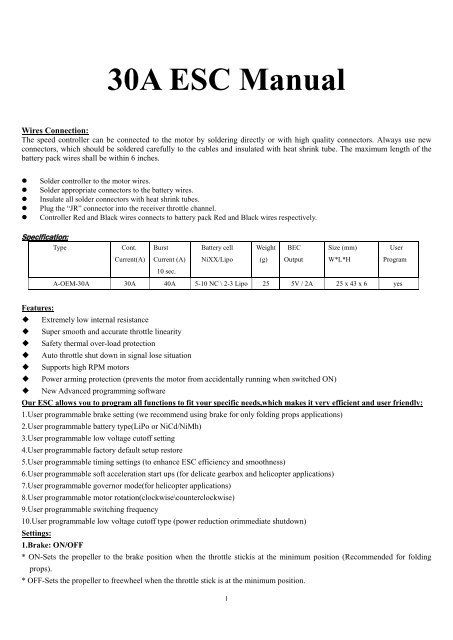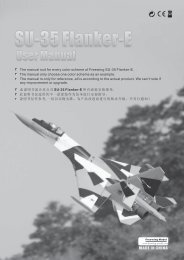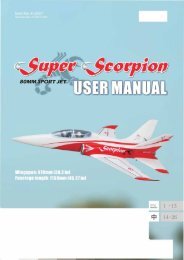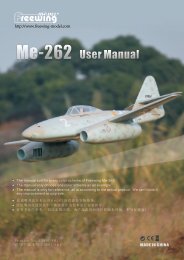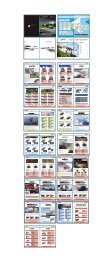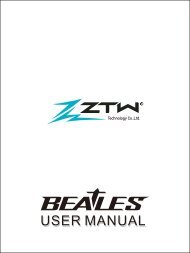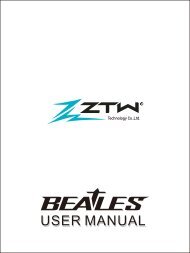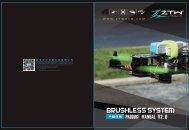ffreewing-f9f-panther-64mm-edf-jet-pnp-30a-esc-user-manual
You also want an ePaper? Increase the reach of your titles
YUMPU automatically turns print PDFs into web optimized ePapers that Google loves.
30A ESC Manual<br />
Wires Connection:<br />
The speed controller can be connected to the motor by soldering directly or with high quality connectors. Always use new<br />
connectors, which should be soldered carefully to the cables and insulated with heat shrink tube. The maximum length of the<br />
battery pack wires shall be within 6 inches.<br />
• Solder controller to the motor wires.<br />
• Solder appropriate connectors to the battery wires.<br />
• Insulate all solder connectors with heat shrink tubes.<br />
• Plug the “JR” connector into the receiver throttle channel.<br />
• Controller Red and Black wires connects to battery pack Red and Black wires respectively.<br />
Specification:<br />
Type<br />
Cont.<br />
Burst<br />
Battery cell<br />
Weight<br />
BEC<br />
Size (mm)<br />
User<br />
Current(A)<br />
Current (A)<br />
NiXX/Lipo<br />
(g)<br />
Output<br />
W*L*H<br />
Program<br />
10 sec.<br />
A-OEM-30A 30A 40A 5-10 NC \ 2-3 Lipo 25 5V / 2A 25 x 43 x 6 yes<br />
Features:<br />
◆ Extremely low internal resistance<br />
◆ Super smooth and accurate throttle linearity<br />
◆ Safety thermal over-load protection<br />
◆ Auto throttle shut down in signal lose situation<br />
◆ Supports high RPM motors<br />
◆ Power arming protection (prevents the motor from accidentally running when switched ON)<br />
◆ New Advanced programming software<br />
Our ESC allows you to program all functions to fit your specific needs,which makes it very efficient and <strong>user</strong> friendly:<br />
1.User programmable brake setting (we recommend using brake for only folding props applications)<br />
2.User programmable battery type(LiPo or NiCd/NiMh)<br />
3.User programmable low voltage cutoff setting<br />
4.User programmable factory default setup restore<br />
5.User programmable timing settings (to enhance ESC efficiency and smoothness)<br />
6.User programmable soft acceleration start ups (for delicate gearbox and helicopter applications)<br />
7.User programmable governor mode(for helicopter applications)<br />
8.User programmable motor rotation(clockwise\counterclockwise)<br />
9.User programmable switching frequency<br />
10.User programmable low voltage cutoff type (power reduction orimmediate shutdown)<br />
Settings:<br />
1.Brake: ON/OFF<br />
* ON-Sets the propeller to the brake position when the throttle stickis at the minimum position (Recommended for folding<br />
props).<br />
* OFF-Sets the propeller to freewheel when the throttle stick is at the minimum position.<br />
1
2.Battery type: LiPo or NiCad/NiMh<br />
* NiCad/NiMh – Sets Low Voltage protection threshold for NiCad/NiMh cells.<br />
* LiPo – Sets Low voltage protection threshold for LiPo cells and automatically detects the number of cells within the pack.<br />
Note: Selecting the NiCad/NiMh option for the battery type, triggers the ESC to automatically set the cutoff threshold to the<br />
factory default of 65%. The cutoff threshold can then be subsequently altered through the Low Voltage protection function, if<br />
required. The ESC will read the initial voltage of the NiCad/NiMh pack once it is plugged in and the voltage read will then be<br />
used as a reference for the cutoff voltage threshold.<br />
3.Low Voltage Protection Threshold ( Cutoff Threshold ):<br />
Low / Medium / High<br />
1) For Li-xx packs- number of cells are automatically calculated and requires no <strong>user</strong> input apart from defining the battery type.<br />
This ESC provides 3 setting options for the low voltage protection threshold ; Low (2.8V)/ Medium (3.0V)/ High (3.2V). For<br />
example : the voltage cutoff options for an 11.1V/ 3 cell Li-Po pack would be 8.4V (Low)/ 9.0V(Med)/ 9.6V(High)<br />
2) For Ni-xx packs-low / medium / high cutoff voltages are 50%/65%/65% of the initial voltage of the battery pack.. For<br />
example: A fully charged 6 cell NiMh pack’s voltage is 1.44V x 6=8.64V,when “LOW” cutoff voltage is set, the cutoff voltage<br />
is: 8.64V x 50%=4.3V and when “Medium” of “High” is set, the cutoff voltage is now 8.64V X 65%=5.61V.<br />
4. Restore factory setup defaults:<br />
Restore- Sets the ESC back to factory default settings;<br />
Brake:<br />
off<br />
Battery type Detect:<br />
LiPo with Automatic Cell<br />
Low voltage cutoff threshold: Medium (3.0V/65%)<br />
Timing setup:<br />
Automatic<br />
Soft Acceleration Start Up: Medium<br />
Governor mode :<br />
OFF<br />
Frequency :<br />
8kHz<br />
Low voltage cutoff type: Reduce power<br />
5.Timing setup : Automatic/ Low / High.<br />
* Automatic – ESC automatically determines the optimum motor timing<br />
* Low (7-22 deg) – Setting for most 2 pole motors.<br />
* High(22-30 deg)-setting for motors with 6 or more poles.<br />
In most cases, automatic timing works well for all types of motors.However for high efficiency we recommend the Low timing<br />
setting for 2 pole motors (general in-runners) and high timing for 6 poles and above (general outrunners). For higher speed,<br />
High timing can be set. Some motors require different timing setups therefore we suggest you to follow the manufacturer<br />
recommended setup or use the automatic timing setting if you are unsure.<br />
Note: Run your motor on the ground first after making any changes to your motor timing!<br />
6.Soft Acceleration Start ups: Very Soft / Soft Acceleration/ Start Acceleration<br />
* Very Soft – Provides initial slow 1.5 sec ramp-up from start to full rpm intended to protect delicate gears from stripping under<br />
instant load. This setting is recommended for either fixed wing models equipped with gearboxes and / or helicopters.<br />
* Soft Acceleration- Provides initial slow 1 sec ramp-up from start to full rpm. This setting is recommended for either fixed<br />
wing models equipped with gearboxes and or helicopters.<br />
* Start Acceleration – Provides quick acceleration start ups with a linear throttle response. This is recommended for fixed wing<br />
models fitted with direct drive setups.<br />
7.Active RPM Control (Heli Governor mode)<br />
* rpm control off<br />
2
* first range: There will be a 5-second delay from start to full rpm, but if the throttle is cutoff after starting, then the next start will<br />
be as normal start.<br />
* second range: There will be a 15-second delay from start to full rpm, but if the throttle is cutoff after starting, then the next start<br />
will be as normal start.<br />
Note: Once the Governor Mode is enabled, the ESC’s Brake and Low Voltage Cutoff Type settings will automatically be reset<br />
to No Brake and Reduce Power respectively regardless of what settings they were previously set.<br />
8.Motor Rotation: Reverse<br />
In most cases motor rotation is usually reversed by swapping two motor wires. However, in cases where the motor cables have<br />
been directly soldered the ESC cables, motor rotation can be reversed by changing the value of setting on the ESC.<br />
9.Switching Frequency : 8kHz/16kHz<br />
* 8kHz – Sets ESC switching frequency for 2 pole motors, e.g. in-runners.<br />
* 16kHz – Sets ESC switching frequency for motors with more than 2 poles, e.g. out-runners.<br />
Although 16kHz is more efficient with our Thrust motors, the setup<br />
default is 8kHz due to the higher RF noises caused at 16kHz.<br />
10.Low Voltage Cutoff Type : Reduce Power / Hard cutoff<br />
* Reduce Power – ESC reduces motor power when the pre-set (recommended).<br />
* Hard Cutoff – ESC instantly cuts motor power when the pre-set Low Voltage Protection Threshold value is reached.<br />
Programming Mode Audible Tones<br />
Programming Mode Audible Tones<br />
ESC Functions<br />
1 Throttle Calibration<br />
(within the first 4 Sec )● ● ● ●<br />
Brake<br />
_ * _ * _ * _ * Brake On /Off<br />
2 Battery type<br />
~ ~ ~ ~<br />
NiCad<br />
~~ ~~ ~~ ~~ LiPo<br />
3 Low Voltage Cutoff Threshold<br />
*_ _* *_ _* *_ _* *_ _*<br />
Low2.8V/50%<br />
*_ _ _* *_ _ _* *_ _ _* *_ _ _* Medium3.0V/60%<br />
*_ _ _ _* *_ _ _ _* *_ _ _ _* *_ _ _ _* High3.2V/65%<br />
4 Restore Factory Setup Defaults<br />
— — — — Restore<br />
5 Timing Setup<br />
– – – – Automatic (7-30°)<br />
–– –– –– –– Low (7-22°)<br />
––– ––– ––– ––– High (22-30°)<br />
6 Soft Acceleration Start Ups<br />
∨∨ ∨∨ ∨∨ ∨∨<br />
Very Soft<br />
∨ ∨ ∨ ∨<br />
Soft Acceleration<br />
∨∨∨ ∨∨∨ ∨∨∨ ∨∨∨ Start Acceleration<br />
7 Governor Mode<br />
_*_ _*_ _*_ _*_<br />
Rpm off<br />
_**_ _**_ _**_ _**_ Heli first range<br />
_***_ _***_ _***_ _***_ Heli second range<br />
8 Motor Rotation<br />
W W W W<br />
Positive/ Reverse<br />
9 Switching Frequency<br />
// // // // 8kHz<br />
3
\\ \\ \\ \\ 16kHz<br />
10 Low Voltage Cutoff Type<br />
_ˉ_ˉ_ˉ_ˉ<br />
Reduce Power<br />
ˉ_ ˉ_ ˉ_ ˉ_<br />
Hard Cut Off<br />
Using Your New ESC<br />
Improper polarity or short circuit will damage the ESC therefore it is your responsibility to double check all plugs for proper<br />
polarity and firm fit BEEORE connecting the battery pack.<br />
Alert Tones<br />
The ZTW ESC is equipped with audible alert tones to indicate abnormal conditions at power up.<br />
If ESC can't enter into working mode after powering up, it indicates that you have not setup throttle calibration.<br />
2. Continuous beeping tone (****) – Indicates that throttle stick is not in the minimum position.<br />
3. Single beeping tone followed by a one second pause (* * * *)– Indicates that the battery pack voltage is not within the<br />
acceptable range. (The ESC automatically checks and verifies the battery voltage once the battery is connected).<br />
4. A single beeping tone followed by a short pause (* * * *) – Indicates that the ESC is unable to detect the normal throttle<br />
signal from the receiver.<br />
Built-in Intelligent ESC Safety Functions<br />
1. Over-heat protection: When the temperature of ESC exceed 110 deg C, the ESC will reduce the output power to allow it too<br />
cool.<br />
2. Lost Throttle signal protection: The ESC will automatically reduces output power to the motor when it detects a lost of<br />
throttle signal for 2 second, a subsequent loss of throttle signal beyond 2 seconds, will cause the ESC automatically to cut<br />
power to the motor.<br />
Powering up the ESC for the first time and setting the Automatic Throttle Calibration<br />
The ZTW ESC features Automatic Throttle Calibration to attain the smoothest throttle response and resolution throughout the<br />
entire throttle range of your transmitter. This step is done once to allow the ESC to “learn and memorize” your Transmitter’s<br />
throttle output signals and only repeated if you change your transmitter.<br />
1.Switch your Transmitter ON and set the throttle stick to its maximum position.<br />
2.Connect the battery pack to the ESC. Wait for about 2 seconds, the motor will beep for twice, then put the throttle in the minimum<br />
position, the motor will also beep, which indicates that your ESC has got the signal range of the throttle from your transmitter.<br />
1.<br />
The throttle is now calibrated and your ESC is ready for operation.<br />
Normal ESC start up procedure:<br />
1. Switch your Transmitter ON and set the throttle to its minimum position.<br />
2. Connect the battery pack to the ESC.<br />
3. When the ESC is first powered up, it emits two sets of audible tones in succession indicating the status of its programming<br />
state.<br />
* The first set of tones denotes the number of cells in the LiPo pack connected to the ESC. (Three beeps (***)indicates a 3<br />
cell LiPo pack while 4 beeps (****) indicates a 4 cell LiPo pack).<br />
* The second set denoting Brake status (one beep(*) for Brake “ON” and two beeps (**) for Brake “OFF”).<br />
*The ESC is now ready for use.<br />
Entering the Programming Mode:<br />
4
1. Switch your Transmitter ON and set the throttle to its maximum position.<br />
2. Connect the battery pack to the ESC.<br />
3. Wait until you hear two short beeps (_ _**) confirming that the ESC has now entered the programming mode.<br />
4. If within 5 seconds, the throttle stick is lowered to its minimum position, an audible tone is emitted confirming that the<br />
throttle calibration setting has changed. If the throttle stick is left in the maximum position beyond 5 seconds, the ESC will<br />
begin the sequence from one function and its associated setting options to another. (Please refer to the table below to cross<br />
reference the functions with the audible tones).<br />
5. When the desired tone for the function and setting option is reached, move the throttle stick down to its minimum position.<br />
ESC will emit two beeps (**) confirming the new setting has been stored.<br />
6. The ESC only allows the setting of one function at a time.<br />
Therefore should you require making changes to other function, disconnect the battery pack and wait 5 seconds to<br />
reconnect the battery and repeat the above steps.<br />
General Safety Precautions<br />
Do not install the propeller (fixed wing) or drive pinion(helicopter) on the motor when you test the ESC and motor for the first time to<br />
verify the correct settings on your radio. Only install your propeller or pinion after you have confirmed that the settings on<br />
your radio is correct.<br />
● Never use ruptured or punctured battery cells.<br />
● Never use battery packs that are known to overheat.<br />
● Never short circuit battery or motor terminals.<br />
● Always use proper insulation material for cable insulation.<br />
● Always use proper cable connetors.<br />
● Do not exceed the number of cells or servos specified by the ESC.<br />
Wrong battery polarity will damage the ESC and void the warranty.<br />
●<br />
●<br />
●<br />
●<br />
●<br />
●<br />
●<br />
●<br />
Install the ESC in a suitable location with adequate ventilation for cooling. This ESC has a built-in over temperature cutoff<br />
protection feature that will immediately cut power to the motor once the ESC temperature exceeds the 230 Deg F/ 110 Deg<br />
C high temperature limit.<br />
Use only batteries that are supported by the ESC and ensure the correct polarity before connecting.<br />
Switch your Transmitter ON and ensure the throttle stick is in the minimum position before connecting the battery pack.<br />
Never switch your transmitter OFF while the battery is connected to your ESC.<br />
Only connect your battery pack just before flying and do not leave your battery pack connected after flying.<br />
Handle your model with extreme care once the battery pack is connected and keep away from the propeller at all times.<br />
Never stand in-line or directly in front of any rotating parts.<br />
Do not immerse the ESC underwater while powered up.<br />
Do fly at a designated flying site and abide by the rules and guidelines set by your flying club.<br />
Trouble Shooting<br />
Trouble Possible Reason Action<br />
Motor doesn’t work,<br />
but there are<br />
audible tones of<br />
automatically<br />
detection of the<br />
number of cells<br />
after powering up<br />
ESC.<br />
The ESC throttle<br />
calibration has not<br />
set up.<br />
Set up the ESC<br />
throttle calibration.<br />
Motor doesn’t work<br />
and no audible tone<br />
emitted after<br />
connecting the<br />
battery. Servos are<br />
not working either.<br />
Poor/loose<br />
Connection<br />
between battery<br />
Pack and ESC.<br />
No power<br />
Poor soldered<br />
connections (dry<br />
joints)<br />
Wrong battery<br />
cable polarity<br />
Clean connector<br />
terminals or replace<br />
connector.<br />
Replace with a freshly<br />
charged battery pack<br />
Re-solder the cable<br />
connections<br />
Check and verify<br />
cable polarity<br />
5
Motor doesn’t work<br />
and no audible tone<br />
emitted after<br />
connecting the<br />
battery BUT servos<br />
are working.<br />
Motor doesn’t work<br />
after powering up<br />
the ESC. An alert<br />
tone with two<br />
beeping bones<br />
followed by a short<br />
pause(** ** ** **)<br />
is emitted.<br />
ESC throttle cable<br />
connected to<br />
receiver in the<br />
reverse polarity<br />
Faulty ESC<br />
Poor / loose<br />
connection<br />
between ESC and<br />
motor<br />
Burnt motor coils<br />
Poor soldered<br />
connections(dry<br />
joints)<br />
The battery pack<br />
voltage is not<br />
within the<br />
acceptable range.<br />
Check the ESC cable<br />
connected to the ESC<br />
to ensure the<br />
connectors are in the<br />
correct polarity.<br />
Replace ESC<br />
Clean connector<br />
terminals or replace<br />
connectors<br />
Replace motor<br />
Re-solder the cable<br />
connections<br />
Replace with a freshly<br />
charged battery pack<br />
Check battery pack<br />
voltage<br />
Trouble Possible Reason Action<br />
Motor doesn’t The ESC is unable to Check and verify<br />
work after detect the normal that the ESC cable<br />
powering up the throttle signal from is connected to the<br />
ESC. An alert the receiver Throttle channel on<br />
tone with a<br />
the receiver.<br />
single beeping<br />
Check the<br />
tone followed by<br />
transmitter and<br />
a short pause<br />
receiver to verify<br />
(* * * * ) is<br />
that there is<br />
emitted.<br />
throttle signal<br />
output.<br />
Motor doesn’t<br />
work after<br />
powering up the<br />
ESC .An alert<br />
tone with<br />
continuous<br />
beeping tones<br />
(****) is<br />
emitted.<br />
Motor doesn’t<br />
work after<br />
powering up the<br />
ESC. ESC emits<br />
two long audible<br />
tones followed<br />
by two short<br />
beeps(_ _ * * )<br />
The throttle stick is<br />
not in the minimum<br />
position at power<br />
up.<br />
Reversed throttle<br />
channel caused the<br />
ESC to enter the<br />
programming mode.<br />
(Connect a spare<br />
servo to verify<br />
throttle channel<br />
operation)<br />
Move the throttle<br />
stick to the<br />
minimum position.<br />
Enter the servo<br />
reverse menu on<br />
your transmitter and<br />
reverse the throttle<br />
channel.<br />
Note: For Futaba<br />
radios set the<br />
throttle channel to<br />
Reverse.<br />
Trouble Possible Reason Action<br />
6
Motor runs in<br />
reverse rotation<br />
Motor stops<br />
running in<br />
flight.<br />
Wrong cables<br />
polarity between<br />
the ESC and the<br />
motor.<br />
Lost throttle signal<br />
Battery Pack<br />
voltage has<br />
reached the Low<br />
Voltage Protection<br />
threshold.<br />
Possible bad cable<br />
connection<br />
Swap any two of the three<br />
cable connections between<br />
the ESC and the Motor or<br />
access the Motor Rotation<br />
function via the ESC<br />
programming mode and<br />
change the pre-set<br />
parameters.<br />
Check proper operation of<br />
the radio equipment.<br />
Check the placement of<br />
the ESC and the Receiver<br />
and check the route of the<br />
receiver’s aerial and ESC<br />
cables to ensure there is<br />
adequate separation to<br />
prevent RF interference .<br />
Install a ferrite ring on the<br />
ESC’s throttle cable.<br />
Land the model<br />
immediately and replace<br />
the battery pack.<br />
Check and verify the<br />
integrity of the cable<br />
connections<br />
Trouble Possible Reason Action<br />
Motor<br />
restarts<br />
Possible RF<br />
Interference at the<br />
The normal operation<br />
of the ESC may be<br />
abnormally flying field.<br />
susceptible to<br />
ESC<br />
surrounding RF<br />
Overheats<br />
interference. Restart<br />
the ESC to resume<br />
normal operation on<br />
the ground to verify<br />
recurrence. If the<br />
problem persists, test<br />
the operation of the<br />
ESC at a different<br />
flying field.<br />
Inadequate<br />
Ventilation<br />
Relocate the ESC to<br />
allow better ventilation<br />
Servos drawing too Use servos that are<br />
much current and over adequately sized for<br />
loading the ESC. the ESC. The<br />
maximum BEC current<br />
drawn should be<br />
Over sized motor or<br />
prop<br />
within the BEC limits.<br />
Prop down or resize<br />
the motor<br />
7


